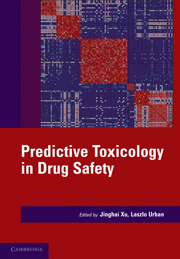Prologue – Predictive toxicology: a new chapter in drug safety evaluation
Published online by Cambridge University Press: 06 December 2010
Summary
In 2007, the U.S. Food and Drug Administration (FDA) issued a report titled “The Future of Drug Safety – Promoting and Protecting the Health of the Public.” In it, strengthening the science that supports drug safety evaluation was recognized as a critical path to improve drug safety assessment. In particular, “developing and qualifying techniques for predictive toxicology” was identified as one of the major unmet needs in advancing scientific approaches to detect, understand, predict, and prevent adverse events (http://www.fda.gov/).
With the cost of developing an FDA-approved medicine approaching $1 billion and time to develop a drug taking 10 to 15 years, late-stage failures or attritions pose a significant burden on the sustainability of the current pharmaceutical research and development (R&D) model. Because 90% of drug candidates that enter clinical development fail to reach the market, the root cause of rising R&D costs is a continuous investment in failure. By last account, clinical safety represents 20% and preclinical toxicology embodies 13% of failed development efforts. Together, drug safety reasons account for one-third of overall failure. Most of the current tools and models used for toxicology and human safety testing are decades old, including many that are recommended by the FDA. Better models, methodologies, and testing paradigms with demonstrated improvement in drug safety prediction than existing practices are clearly needed. Predictive toxicology, aimed at addressing this challenge using a combined knowledge and insight from all fields of science, is the central topic of this book.
- Type
- Chapter
- Information
- Predictive Toxicology in Drug Safety , pp. xi - xiiPublisher: Cambridge University PressPrint publication year: 2010



